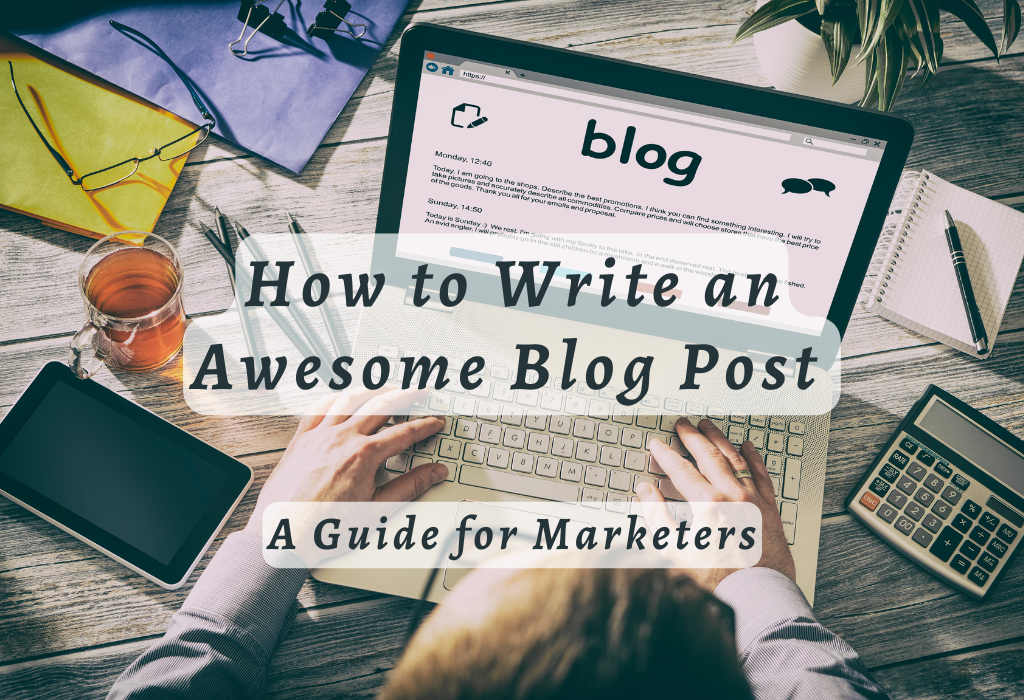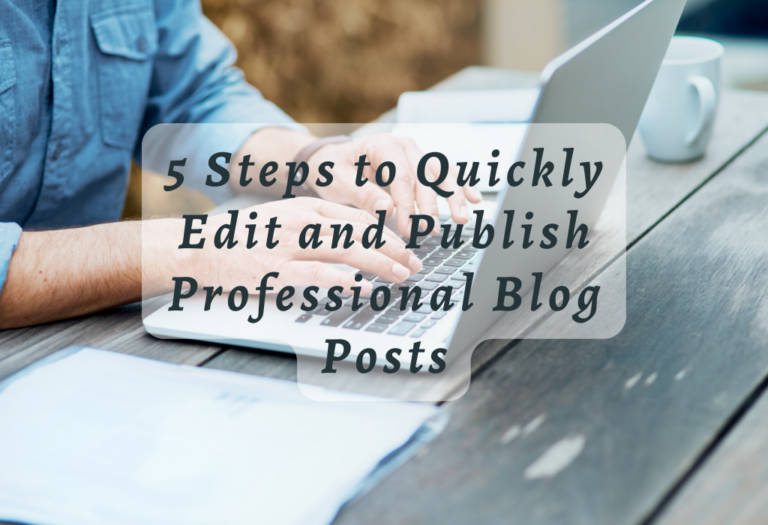How to Write an Awesome Blog Post in 6 Steps: A Guide for Marketers
Writing an awesome blog post doesn’t have to be difficult. With these 6 simple steps, you can create a compelling and engaging piece of content that will draw in your readers and keep them coming back for more. From researching the topic to optimizing it for SEO, we’ll show you how easy it is to write an awesome blog post in just 6 steps.

Research Your Topic
Researching your topic is an essential step in creating a successful blog post. It could appear as though the most difficult part of blogging is trying to decide what to write about. In point of fact, it’s probably the obstacle that most individuals face while trying to write on a daily basis. The following are the most important points to keep in mind about your content:
Identifying your target audience is the next step to ensure that you are providing content that resonates with them. Ask yourself questions such as: Who am I writing for? What do they need to know? What topics would be of interest to them? Once you have identified who your readers are, it’s time to gather relevant information about the topic at hand. Utilize reliable sources and take notes on key points so that you can refer back when needed.
You should also do some study in your field of expertise or in the sector that you work in. What is it that individuals find so exciting or motivating? What is now popular on social media platforms? Is there a point in the process where you can feel the annoyance of the customers yet they aren’t getting answers to their questions? Analyzing the competition will give your insight into what other bloggers are doing in terms of content and SEO optimization, which can help inform how you approach yours. Take note of their headlines, structure, visuals, keywords used etc., but don’t copy them; use this knowledge to create something unique and engaging for your own readership base.
Once you have researched your topic and identified your audience, the next step is to create an outline structure for your post. This will help guide you in crafting a well-structured blog post that meets all of your readers’ needs.
Outline Your Post
Brainstorm Ideas
Before beginning to write, it is important to brainstorm ideas for the post. Think about what topics you want to cover and how they relate to each other. Brainstorming can help you come up with new angles or perspectives on your topic that may not have been considered before.
Create an Outline Structure
Once the ideas are in place, create a structure for the post by outlining its main points and sub-points. This will help keep your post organized and focused on its key messages. It will also make it easier for readers to follow along as they read through your content.
Making Schedules
Establishing a writing schedule is essential when creating long-form blog posts like this one. Set aside time each day or week dedicated solely to writing so that you stay on track and don’t get overwhelmed with all of the tasks associated with content creation. Having a plan in place will ensure that deadlines are met and quality content is produced consistently over time
Outlining your post is an important step in the writing process. It helps to ensure that your blog post will be well-structured and organized. Now, let’s move on to the next step – Writing Your Post.
Write Your Post
When it comes to attracting the attention of the people who are supposed to read your content, the most crucial parts are the title and the introduction. Therefore, you need to ensure that you set aside sufficient time to design an attention-grabbing title.
After that, compose an introduction that will pique the interest of your readers and encourage them to continue reading the rest of your content.
Provide a brief overview of the content of your post. Use language that is easy to understand and avoid jargon or overly technical terms. Additionally, consider using storytelling elements such as anecdotes or examples to draw in your audience.
Discover how much time it takes to write a 1000-word article.
Develop Quality Content with Examples and Evidence
Once you have crafted an engaging introduction, it is time to develop quality content for your post. Be sure to provide evidence-based facts and figures when making claims or statements about topics related to your post. If possible, include real-life examples from customers or industry experts who can back up any points made in the article.
Include Visuals to Enhance Your Post
Visuals are essential for capturing readers’ attention and helping them better understand complex concepts discussed in the post. Include images, videos, info graphics, charts/graphs, etc., where appropriate throughout the article so readers can quickly grasp key ideas without having to read through long blocks of text. Also ensure visuals are relevant by including captions that explain what they represent if needed.
Once you have crafted a compelling introduction and developed quality content with examples and evidence, it’s time to move on to optimizing your post for SEO.
Optimize for SEO
Search engine optimization (SEO) is an essential part of content marketing and can help increase visibility for your blog post. Your blog post’s readability will improve dramatically if it is both well written and formatted in the appropriate manner. It will also make it simpler for search engines to index your blog article, which will lead to improved search results that are more relevant to your query.
Choose Keywords Strategically
When selecting keywords for SEO purposes, it’s important to consider the intent behind each search query. For example, if you are writing a blog post about “content marketing strategies” then you would want to include related terms such as “social media marketing” or “search engine optimization” in order to capture more relevant searches from users. Additionally, you should also research which keywords have higher search volumes so that your post has the best chance of being seen by potential readers.
Incorporate Keywords into Content Appropriately
Once you have identified the right set of keywords for your blog post, it is important to ensure that they are used throughout the content in a natural way without sounding forced or repetitive. This means using variations of the keyword phrase while still maintaining readability and flow within sentences and paragraphs. Additionally, be sure not to overuse any particular keyword as this could lead to penalties from search engines like Google due to keyword stuffing practices.
Internal linking
Internal linking is another great way to boost SEO performance on your blog posts as it helps create pathways between pages on your website, making it easier for both humans and bots when navigating through different sections of your site. By adding links within text blocks or images that link back to other pieces of content on your website, you can keep visitors engaged longer while increasing page views at the same time.
Once you have optimized your blog post for SEO, it’s time to focus on editing and proofreading the content to ensure accuracy and clarity.
Edit and Proofread Your Post
Before publishing your blog post, it is important to edit and proofread it carefully. This will help ensure accuracy of facts and figures as well as clarity of voice throughout the piece. Checking for grammar and spelling errors is also essential to maintain professionalism in your writing style.
Check for Grammar and Spelling Errors
Grammatical mistakes can make a post look unprofessional, so it’s important to double-check every sentence before you hit publish. Make sure all words are spelled correctly, that punctuation marks are used properly, and that sentences flow logically from one point to the next. If possible, have someone else read through your post before you share it with the world – they may catch something you missed.
Ensure Clarity and Consistency of Voice
Your readers should be able to understand what you’re saying without having to re-read or decipher complex sentences or jargon. Keep languages simple yet engaging by using active verbs instead of passive ones wherever possible; this will give your writing more energy while still conveying clear messages about each topic discussed in the post. Additionally, try not to switch between different tones too often within a single article – consistency helps keep readers engaged until the end.
Review for Accuracy of Facts and Figures
It is essential that any data included in a blog post is accurate; if not, readers may lose trust in both you as an author and your content overall. Double check sources when necessary (e.g., if referencing statistics) or provide links back to original sources whenever possible so readers can do their own research on topics discussed within the article if desired. Doing this ensures credibility while also providing additional value for those who want more information on specific points made throughout the piece.
Proofreading your post is essential for creating an awesome blog post. Once you have finished editing, it’s time to promote your post and measure the results.
Promote Your Post
Promoting your post is an essential part of content marketing and SEO. After you have published a blog post, it’s important to share it on social media platforms like Facebook, Twitter, Instagram and LinkedIn in order to reach more people. You can also leverage influencers who have large followings on these platforms to help spread the word about your post. This will increase visibility for your content and potentially bring in more readers.
Engaging in online communities is another great way to build awareness about your blog post among potential readers who may be interested in what you have written about. Participating in relevant conversations or joining groups related to the topic of your blog post can be beneficial for increasing its exposure as well as gaining valuable feedback from other users.
FAQs in Relation to How to Write an Awesome Blog Post in 6 Steps
Conclusion
By researching your topic, outlining your post, writing it, optimizing for SEO, editing and proofreading it, and promoting it afterwards, you can ensure that the content you produce is of high quality and resonates with your target audience. With these seven simple steps as a guide, you can confidently create amazing blog posts that will have lasting impact.
Do you want to write an awesome blog post that will get noticed and drive more traffic? We can help! Our content marketing and SEO services are designed to optimize your posts for maximum visibility, so they reach the right audience. With our expert guidance, you’ll be able to create compelling content that engages readers while also boosting your search engine rankings. Contact us today and let’s start crafting a winning strategy together!





